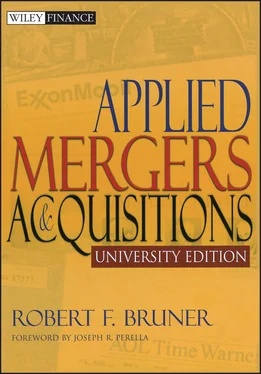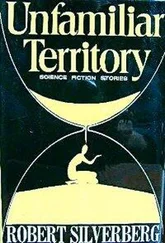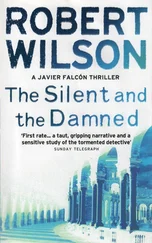Geoffrey Meeks (1977) explored the gains from merger for a sample of transactions in the United Kingdom between 1964 and 1971. This study draws upon a relatively large sample (233 observations), and tests the change in profitability following the merger. Meeks looks at the change in return on assets 8 (ROA) compared to the change in ROA for the buyer’s industry. His chief finding is excerpted in Exhibit 3.9. Meeks’ findings reveal a decline in ROA for acquirers following the transaction, with performance reaching the nadir five years after. For nearly two-thirds of acquirers, performance is below the standard of the industry. He concludes that the mergers in his sample suffered a “mild decline in profitability” ( page 25).
Mueller (1980) edited a collection of studies of M&A profitability across seven nations (Belgium, Germany, France, Netherlands, Sweden, United Kingdom, and United States). All the studies applied standard tests and data criteria and therefore afford an unusually rich cross-border comparison of results across parts of Europe and the United States. The research tested theories about changes in size, risk, leverage, and profitability. Profitability was measured three ways: (1) profit divided by equity; (2) profit divided by assets, and (3) profit divided by sales. The changes in profitability for an acquirer (measured as the difference between the postacquisition performance and the average profitability for five years before the transaction) were compared to similar measures for two benchmark groups: firms matched on the basis of size and industry and who made no acquisitions, and a general sample of firms that neither made acquisitions nor were acquired during the observation period. Consistent with Meeks’ finding, Mueller’s work finds that acquirers are significantly larger than targets, acquirers have been growing faster than their peers and than their targets, and are more highly leveraged than targets and peers. Regarding profitability, acquirers show no significant differences—the specific data for the United States are generally representative of the findings across many nations. Exhibit 3.10on page 53gives an excerpt of these findings.
| Study |
Cumulative Abnormal Returns |
Sample Size |
Sample Period |
Event Window (Days) |
% Positive Returns |
Notes |
| Halpern (1973) |
+$27.35 MM |
77 |
1950–1965 |
(–140,0) |
N/A |
Mergers. |
| Langetieg (1978) |
0% |
149 |
1929–1969 |
(0,60) |
46% |
Mergers; uses effective date as event baseline. |
| Firth (1980) |
–£36.6 MM |
434 |
1969–1975 |
(–20,0) |
N/A |
U.K. acquisitions. |
| Bradley, Desai, Kim (1982) |
+$17 MM |
162 |
1962–1980 |
(–20,5) |
N/A |
Tender offers; referenced through Jensen, Ruback (1983). |
| Bradley, Desai, Kim (1983) |
+$33.9 MM |
161 |
1963–1980 |
(–20,5) |
N/A |
Referenced through Weidenbaum, Vogt (1987). |
| Malatesta (1983) |
+$32.4 MM * |
30 |
1969–1974 |
(–20,20) |
N/A |
Mergers. |
| Varaiya (1985) |
+$60.7 MM |
N/A |
N/A |
(–60,60) |
N/A |
Referenced through Weidenbaum, Vogt (1987). |
| Bradley, Desai, Kim (1988) |
+$117 MM (7.43%) * |
236 |
1963–1984 |
(–5,5) |
75% |
Tender offers only; subperiod data available for 7/63–6/68, 7/68–12/80, 1/81–12/84; combined returns have not changed significantly over time. |
| Lang, Stulz, Walkling (1989) |
+11.3% * |
87 |
1968–1986 |
(–5,5) |
N/A |
Tender offers only. |
| Franks, Harris, Titman (1991) |
+3.9% * |
399 |
1975–1984 |
(–5,5) |
N/A |
Mergers and tender offers. |
| Servaes (1991) |
+3.66% * |
384 |
1972–1987 |
(–1,close) |
N/A |
Mergers and tender offers. |
| Bannerjee, Owers (1992) |
+$9.95MM |
33 |
1978–1987 |
(–1,0) |
N/A |
White knight bids. |
| Healy, Palepu, Ruback (1992) |
+9.1% * |
50 |
1979–1984 |
(–5,5) |
N/A |
Largest U.S. mergers during period. |
| Kaplan, Weisbach (1992) |
+3.74% * |
209 |
1971–1982 |
(–5,5) |
66% |
Mergers and tender offers. |
| Berkovitch, Narayanan (1993) |
+$120 MM * |
330 |
1963–1988 |
(–5,5) |
75% |
Tender offers only. |
| Smith, Kim (1994) |
+8.88% *+3.79% * |
177 |
1980–1986 |
(–5,5) (–1,0) |
79.1% 73.8% |
Tender offers only. |
| Leeth, Borg (2000) |
+$86 MM |
53 |
1919–1930 |
(–40,0) |
56.6% |
In 1998 dollars. |
| Mulherin (2000) |
+2.53% * |
116 |
1962–1997 |
(–1,0) |
66% |
A sample of incomplete acquisitions. |
| Mulherin, Boone (2000) |
+3.56% |
281 |
1990–1999 |
(–1,+1) |
N/A |
|
| Houston et al. (2001) |
+0.14% (1985–1990) +3.11% *(1991–1996) +1.86% *all |
27 37 64 |
1985–1996 |
(–4,1) |
N/A |
Deals in which both parties are banks. |
| Beitel et al. (2002) |
+1.2% * |
98 |
1985–2000 |
(–1,0) |
65% |
Sample of European bank mergers. |
| Fan, Goyal (2002) |
+1.9% * |
2,162 |
1962–1996 |
(–1,+1) |
N/A |
|
| Kuipers, Miller, Patel (2003) |
+2.99% * |
120 |
1982–1991 |
(–1,0) |
N/A |
Foreign acquirers and U.S. targets. |
| Gupta, Misra (undated) |
+7.06 MM |
393 |
1980–1998 |
(–1,0) |
53% |
Sample of acquirers and targets in the financial sector. |
Unless otherwise noted, event date is announcement date of merger/bid.
*Significant at the 0.95 confidence level or better.
| Author, Sample Period, and Sample Size |
Major Findings |
| Meeks (1977) 1964–1972 233 mergers |
ROA for acquiring firms in the United Kingdom consistently declined in postmerger years. |
| Salter, Weinhold (1979) Sample period unknown 16 acquirers |
Average ROE for acquirers was 44% below the NYSE ROE, and the ROA was 75% below the NYSE. |
| Mueller (1980) 1962–1972 287 mergers |
Using measures such as ROE, ROA, and ROS, U.S. firms engaging in merger activity were less profitable, although not significantly so, than comparable firms. Similar conclusions were reached for representative European countries. |
| Mueller (1985) 1950–1992 100 firms involved in mergers |
The largest 100 firms in the United States involved in merger, both conglomerate and horizontal, suffer significant losses in market share. |
| Ravenscraft, Scherer (1987 article) 1950–1977 471 mergers |
Significant negative relationships between operating ROA and tender offer activity. Other things being equal, firms with tender offer activity were 3.1% less profitable than firms without the activity. |
| Ravenscraft, Scherer (1987 book) 1950–1977 471 mergers |
ROA declined on average 0.5% per year for target companies that were merged under pooling accounting. |
| Herman, Lowenstein (1988) 1975–1983 56 hostile takeovers |
ROC for acquirers (using tender offers) increased from 14.7% to 19.6% postmerger in 1975–1978. A similar measure for the 1981–1983 period showed a decrease in ROC. |
| Seth (1990) 1962–1979 102 tender offers |
Using a modeled (rather than a market) value of equity based on expected cash flows and a required rate of return, acquisitions returned 9.3% in additional equity value. Operational synergies, in the form of additional cash flows, returned 12.9%, and financial synergies, from changes in the required rate of return, were –3.6%. |
| Healy, Palepu, Ruback (1992) 1979–1984 50 mergers |
In 50 largest U.S. mergers, merged firms showed significant abnormal improvements in asset productivity (asset turnover), but no significant abnormal increases in operating cash flow margins. |
| Chatterjee, Meeks (1996) 1977–1990 144 mergers |
Before 1985, U.K. mergers showed no significant increase in profitability after merger. Between 1985 and 1990, firms showed significant improvement in accounting profitability returns (13–22%) in years following merger, presumably because of changes in accounting policy. |
| Dickerson, Gibson, Tsakalotos (1997) 1948–1977 613 mergers |
For the first five years, postacquisition, ROA for acquirers is 2% lower than ROA for nonacquirers. |
| Healy, Palepu, Ruback (1997) 1979–1984 50 mergers |
Based on the 50 largest U.S. mergers, operating cash flow returns as a result of merger met but did not exceed the premium paid for target; therefore M&A is a zero net present value (NPV) activity. Stock price activity at time of announcement was related to postacquisition cash flow performance. |
| Parrino, Harris (1999) and Parrino, Harris (2001) 1982–1987 197 mergers |
Buyers experienced a significant +2.1% operating cash flow return after merger. This return is defined as operating cash flow divided by market value of assets. Postmerger returns were significantly higher where the buyer and target shared at least one common business line, or merged to take advantage of technology. |
| Ghosh (2001) 1981–1995 315 mergers |
Buyers experienced returns on assets no different from a control sample following acquisitions. But cash flows increased significantly following acquisitions made with cash, and declined for stock acquisitions. |
| Carline, Linn, Yadav (2001) 1985–1994 86 mergers |
Buyers and targets, combined, underperformed their industry peers in five years before merger, and outperformed their peers in five years after. Median change in performance of industry adjusted operating cash flows was +6.39%. * |
| Sharma, Ho (2002) 1986–1991 36 mergers, Australian sample |
Comparing the three years before merger to the three years after, buyers showed significantly lower return on equity, return on assets, profit margin, and earnings per share. |
ROE = Return on equity.












